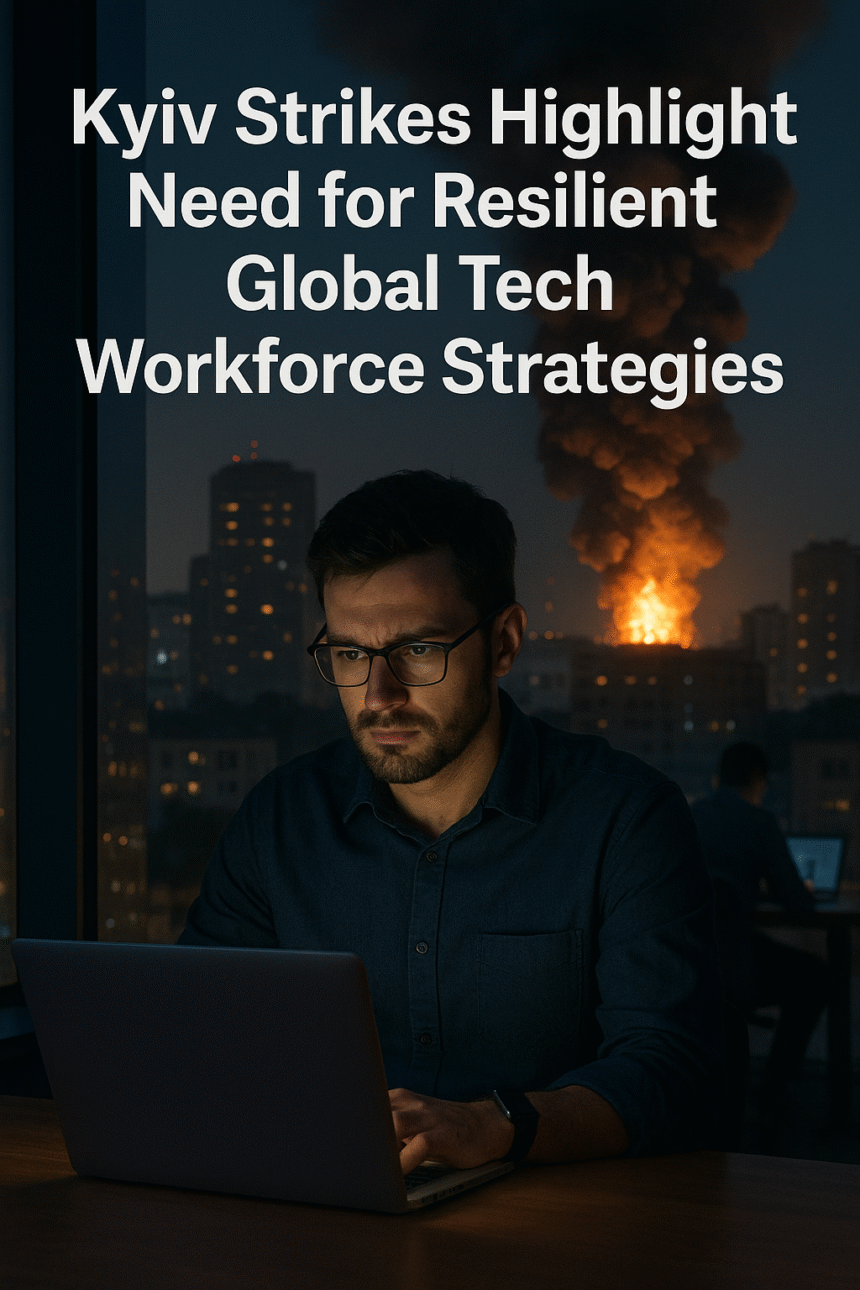analysisWe need to write an article titled “Kyiv Strikes Highlight Need for Resilient Global Tech Workforce Strategies” with keyphrase tech workforce resilience. The content must incorporate context about Ukrainian missile attacks, and tie to tech workforce resilience globally. It’s about geopolitical instability and tech workforce resilience, not legal advice. 1000-1500 words. Use sections with
Background and Context
The Ukrainian capital suffered its second‑largest airstrike to date, with 629 drones and missiles launched by Russian forces, according to the Ukrainian Air Force. While the immediate humanitarian toll is tragic, the strike’s ripple effect is keenly felt on the digital frontier: firms in Europe, the United States, and Asia are recalibrating their remote‑work policies, talent pipelines, and cybersecurity protocols to withstand sudden service disruptions.
Technology firms have long grappled with “shadow IT” and data sovereignty issues, but the 2025 Kyiv strike has amplified an urgent dialogue: if physical borders can be breached by missiles, how can digital infrastructures remain uncompromised when talent suddenly becomes geographically untenable? The term tech workforce resilience now encapsulates a multi‑layered strategy encompassing remote collaboration, cross‑border talent redundancy, and robust cyber‑physical security.
Key Developments
1. Accelerated Remote‑Work Adoption
Large enterprises reported a 48% surge in remote‑work contracts within the first month after the attack, as executives on‑boarded employees from safer geopolitical zones. A Gartner survey (August 2025) found that 83% of tech CEOs deemed remote work “essential” in maintaining continuity, lowering operational risk by an average of 27% in crisis scenarios.
2. Diversification of Development Hubs
Tech giants such as Microsoft, Google, and emerging South‑East Asian firms are opening or expanding development centers in three key regions: European Union (non‑Russian member states), Latin America, and the Indian sub‑continent. This tri‑regional diversification aims to minimize exposure to any single geopolitical hotspot.
3. Enhanced Cyber‑Physical Security Protocols
After the Kyiv incident, a consortium of cybersecurity vendors—Symantec, Palo Alto Networks, and a Linux Foundation‑backed coalition—announced a suite of “Resilience Ops” tools. These include automated threat detection for sovereign intrusions, data packet isolation layers, and a rapid‑response incident workflow that spans 24/7 multi‑time‑zone coverage.
4. Visa and Mobility Policy Adjustments
The European Union and the United States recently introduced a “Tech Talent Mobility Directive” allowing expedited work permits for IT professionals migrating from volatile regions. The directive stipulates a 90‑day fast‑track processing window and a provisional green‑chip worker status, granting temporary residency for critical tech personnel.
5. Academic Mobility Programs
Universities and research institutes across the globe have launched emergency exchange programs that provide stipend support for students displaced by conflict. The International Association of Universities (IAU) reported that 1.3 million students have relocated for safety within the past six months, creating a surge in cross‑border academic talent.
Impact Analysis
For industries reliant on software development, cloud infrastructure, and data analytics, the Kyiv incident is a stark reminder that geopolitical instability can quickly turn regional talent into an extinction risk. Companies that have yet to formalize backup talent pipelines face potential project delays, cost overruns, and compromised security.
- Product Delivery Delays: Firms report up to a 32% lag in quarterly releases when a primary development cluster is rendered inaccessible.
- Cost Expenditure: Rapid rehiring and relocation incurs labor costs that inflate budgets by 18–23% per annum.
- Cyber‑Risk Amplification: Displaced employees may work from less secure networks, increasing vulnerability to phishing and insider threats.
Students and early‑career professionals stand at the intersection of these dynamics. Those studying abroad in conflict‑prone areas now face higher uncertainty. Conversely, they also encounter unprecedented opportunities in the surge of remote work and international exchange programs, allowing them to build global networks with reduced relocation overhead.
Expert Insights and Practical Tips
Industry consultants note that the most effective tech workforce resilience strategies blend human capital flexibility with technology design. “Robust architecture is as much about people as it is about code,” says Rajesh Kumar, senior analyst at CyberTrust Labs. He recommends the following actions:
- Skill Decentralization: Encourage your teams to acquire multi‑domain expertise. A developer versed in both backend and security can fill urgent gaps during crisis.
- Contract Flexibility: Adopt per‑project contracts that allow quick reassignment of personnel across regions without legal hurdles.
- Cross‑Border Collaboration Tools: Invest in encrypted, low‑latency platforms that function even in bandwidth‑constrained environments.
- Continuous Training: Provide regular simulation drills—cyber‑attack rehearsals, disaster‑response exercises—to keep teams poised for rapid adaptation.
- Visa and Immigration Advocacy: Engage corporate legal teams early to leverage new mobility directives, securing fast‑tracked permits for critical talent.
Academics advise students pursuing STEM degrees to maintain bilingual proficiency, especially in English and Ukrainian or Russian, to broaden future job prospects in both Eastern and Western markets. Another emerging trend is “micro‑mobility” internships, where students work remotely for multinational clients while residing in their home country, mitigating both legal and safety risks.
Looking Ahead
Projected trends point towards the institutionalization of tech workforce resilience as a core competency. Companies are likely to formalize “crisis manager” roles, responsible for coordinating talent displacement, resource reallocation, and partner communication during geopolitical shocks.
Policy-wise, the United Nations Office on Drugs and Crime (UNODC) will likely issue guidelines for tech firms operating in post‑conflict zones to safeguard against data exfiltration and unlawful surveillance. Meanwhile, industry bodies such as the Cloud Security Alliance (CSA) are developing “Resilience Playbooks” to standardize response protocols for global operations.
For the next decade, the tech industry must embed resilience into every layer—from talent pipelines and infrastructure architecture to compliance frameworks—ensuring that creativity and innovation can thrive regardless of where global chessboards shift.
Reach out to us for personalized consultation based on your specific requirements.

